Thursday 7th April 2022

Congratulations to this week’s 31 lucky winners in the DfT’s Bus Service Improvement Plans lottery. Roughly half of England is destined to enjoy buses emulating what the Secretary of State describes as the “success of London” (which, by the way, confirms for any doubters the DfT really does suffer from some kind of bipolar disorder – check out recent critical comments by the very same Secretary of State of the Mayor and TfL’s overseeing of the Capital’s buses and their unsustainable finances) while the other half just have to throw their lottery ticket in the bin and get on with the job of cutting back buses as ever they have.
Interestingly many of the ‘Haves’ are already renowned for providing attractive bus services with a track record of growing the market so they look set to get even more successful with better networks and infrastructure as well as new ticket deals, more frequent services and enhanced information provision while the missing-from-the-list ‘Have Nots’ face an uncertain future. I’m not sure that’s what ‘levelling up’ was meant to be about.
Meanwhile the Campaign for Better Transport attracted more negative bus headlines in the main stream media this week having totted up the number of bus services withdrawn in England over the last decade and worked out this comes to “more than one in four” (27 per cent). Of course, such figures grab headlines but are always somewhat misleading as they relate to “live bus registrations” which takes no effect of changes to other “registrations” which might mean gaps caused by service withdrawals have been plugged.
It also makes no reference to how many passengers have been impacted by such withdrawals. Certainly not “more than one in four” if my about-to-be-withdrawn bus service travelling experiences in Kent are anything to go by.
I’ve been taking a few rides on some of the bus routes under threat in Kent to see just how many people might be impacted as that county aims to save £2.2 million from its annual £6.1 million bus funding bill so it can live within its wider financial means.
Interestingly Kent County Council were one of the 31 lucky lottery winners with a nice £35.1 million heading its way for its Bus Service Improvement Plan. But where does that leave its £2.1 million subsidy funding gap? Does it change things? Leaving villages and hamlets without any bus services at all hardly seems in the spirit of ‘levelling up’.
I highlighted the £208,000 saving Kent aim to make by withdrawing routes X1 and X2 between Kings Hill and West Malling and Maidstone in my previous blog on this topic, explaining how the regular driver recalled the afternoon journeys carried a couple of passengers (in total) between them.
Here’s a look at three more substantive routes on Kent’s Hit List currently out to public consultation. Obviously my experience is but a snapshot of a random journey or two so may not be typical of the whole service, but I reckon I’m not far off the mark of what a typical impact will be.
My first ride a couple of weeks ago was a circuit on Go-Coach’s routes 474/475 which run a rural circular (clockwise and anti-clockwise) route from the Bluewater shopping centre to serve the village of Longfield as well as the hamlets of Bean, Besham, Southfleet and New Barn.
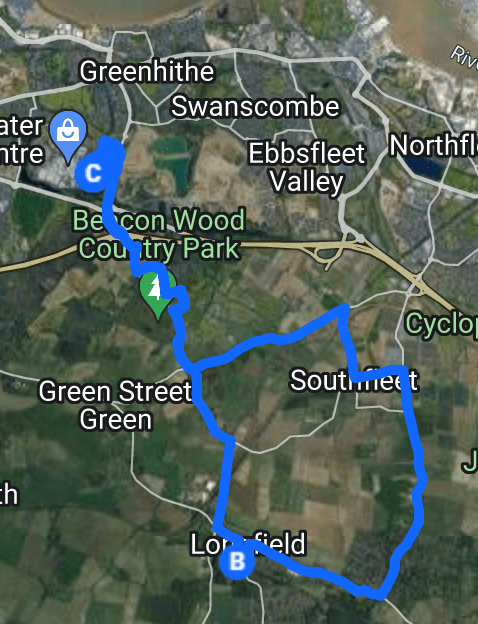
It runs hourly on Mondays to Saturdays with the first journey leaving Longfield Station at 07:25 and then pretty much keeps going with hourly departures of the 45 minute circuit until the last journey leaves Bluewater at 19:10.

The route costs Kent £114,847 a year. The proposal is to withdraw the route in its entirety with no replacement.

Longfield is also served by Arriva’s route 423 every couple of hours or so to Bluewater and Dartford as well as route 489 to Gravesend every 90 minutes also serving Southfleet but other hamlets, notably quite a large residential area called Bean frustratingly only about a mile and a half from Bluewater – but not really walkable due to road layouts – will be left completely bus less.

I took the 10:10 departure from Bluewater which is a clockwise route 475. We carried no-one from the shopping centre (which, to be fair, had barely opened) and picked up no-one on the ciruit until we got to New Barn, just east of Longfield, where two concessionary passholding and empty shopping bag carrying passengers boarded. The driver was so surprised to see them waiting he nearly left them behind. He told me later he seldom if every picks up at that point. We spent a couple of minutes waiting time alongside Longfield railway station – it’s on the Victoria to Gillingham route and enjoys a half hourly service.

We headed on around the circuit to Bluewater including taking in the residential area of Beam where we picked two more passengers up.

All four alighted at Bluewater and the driver was telling me numbers are usually very low. He thought Austin Blackburn, the entrepreneurial owner of Go-Coach Hire might be thinking of other options if Kent’s proposed cuts go ahead – it was all the talk while we waited time at Longfield station. Reducing the frequency to two-hourly or converting it to a DRT based service were two of the options mentioned but of course, these wouldn’t save the main costs – a bus and a driver.
It’s not looking good for the 474/475.

Last week I made a similar venture over to Edenbridge to take a ride around the half-hourly frequency anti-clockwise circuit of the Go-Coach Hire operated town route E1 which is also on Kent’s Hit List with a stated saving of £141,363 from a complete withdrawal of the route.

The 23 minute circuit runs between 09:30 and 12:23 when there’s a half hour’s gap for the driver’s break and then there are three after lunch departures between and including 13:00 and 14:00. One can immediately see the route is fitted in between peak hour school journeys, so losing the off-peak fill-in will be something of a blow for Go-Coach in making the sums add up for the bus and driver’s full day’s work.

I caught the 10:00 journey from outside Edenbridge’s Post Office. The bus had arrived in good time at 09:50 from its first circuit and brought one passenger in. Two passengers boarded with me but didn’t stay on the bus for long. They’d both alighted as we headed north towards Edenbridge station (the one on the line to Redhill) – a journey which is possible on other routes serving Edenbridge including Metrobus routes 231/233 to Tunbridge Wells – with about 11 journeys a day – and Southdown route 236 (East Grinstead to Oxted) – with six journeys a day – including one at 10:09.

We picked up two passengers who boarded at Edenbridge station, one of whom got off by Waitrose (at the southern end of the town) and one went right round the circuit to the Post Office. We didn’t pick anyone else up.

I watched the next departure leave at 10:30 with one on board.
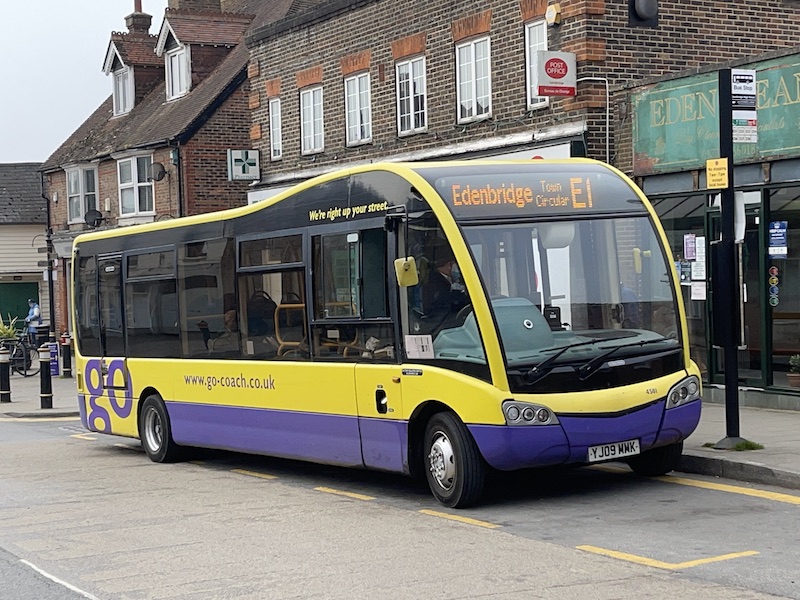
Bearing in mind the bus must be committed to other work at school times, unless that is under thereat it will continue, I wonder whether this route might scrape by assuming it’s marginally costed, but the loss of the County’s income for Go-Coach Hire at £141,363 might be just too high a price to forgo.

The signs aren’t looking good for the E1 unless Go-Coach bears the subsidy loss.
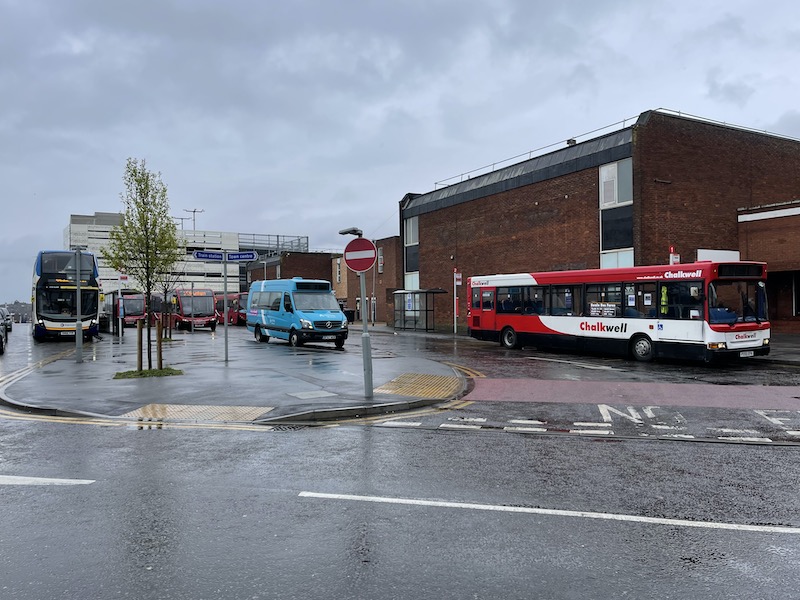
My third venture was on Monday this week checking out tendered bus routes based on Sittingbourne operated by Chalkwell which are currently funded to the tune of £313,698 by Kent County Council and are all on the Hit List.
There are five numbered routes in the package – 8, 9, 343, 344 and 345. These provide a network around the town of Sittingbourne as well as journeys to the surrounding rural area.

It’s not clear from Kent’s papers if all the journeys are under threat. Route 8, for example comprises three off peak journeys from the hamlet of Conyer, 18 minutes to the east of Sittingbourne (beyond Teynham) then across Sittingbourne and down to Borden 10 minutes to the south west of the town. It’s listed in Kent’s list as “withdrawal of six off-peak journeys”. It looks to me there are only six off peak journeys and even then that’s counting each return journey as two, which would mean the complete service being withdrawn.

I took a ride out to Conyer at 09:47 from Sittingbourne (no-one else did) but we brought nine shoppers, six shopping trolleys and two disabled wheelies back in, which I thought was pretty good going.
There’s a peak hour return journey to Conyer on route 344 but that whole route (along with the 343/345 is for the cull) meaning this hamlet will be completely isolated which I would guess will cause considerable hardship for residents.
Passengers from most of Teynham have alternative routes along the A2 or the train but Conyer looks like a withdrawal too far to me.

I did a circuit on town route 9 – this takes in an area to the north west of the town known in the timetable as Kenilworth Court before embarking on a rather twisty turny circular around the south of the town before diving down to a relatively recent up market residential expansion in the south east corner called Eden Village.
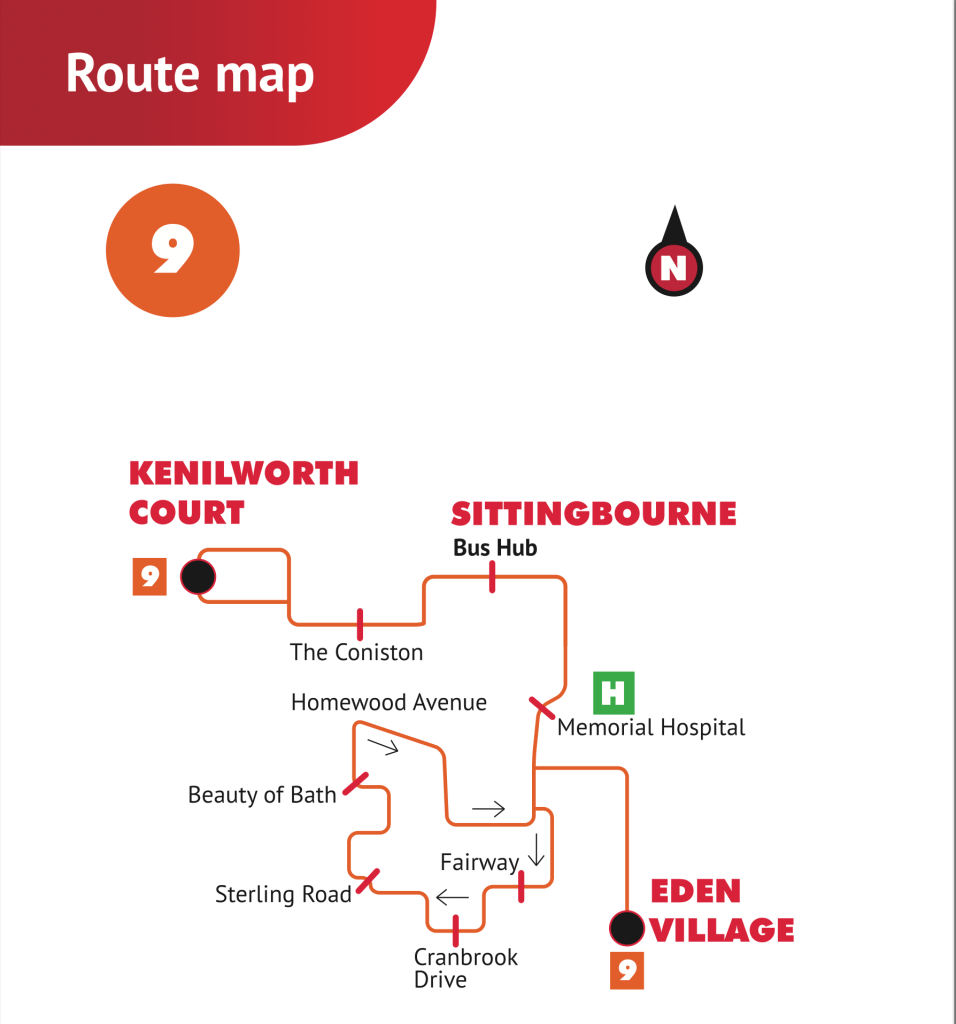
There are a couple of peak journeys to Kenilworth Court but the rest of the route has half a dozen hourly off peak circuits. I caught the 13:07 circuit.

We carried no-one. No-one at all. Other journeys I saw coming in from Kenilworth Court brought just one or two passengers in.
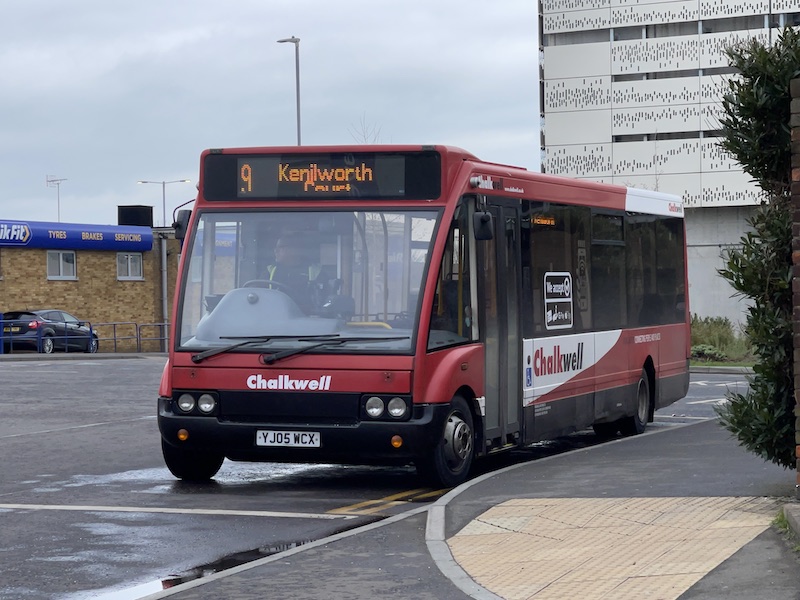
Sittingbourne was famous for being Arriva’s test bed for its first Click DRT trial. That failed, and sadly it looks as though the traditional timetable bus route in the town has had its day too. Sittingbourne looks set to be one of the first sizeable towns to lose its complete town bus service leaving just the inter-urbans to Chatham, Maidstone, Sheerness and Canterbury to continue.
The three rural routes 343, 344 and 345 will be withdrawn “in their entirety” according to Kent’s proposals. It continues “the service operates Monday to Saturday providing the only public transport for rural parts of Sittingbourne including journeys for schoolchildren”.
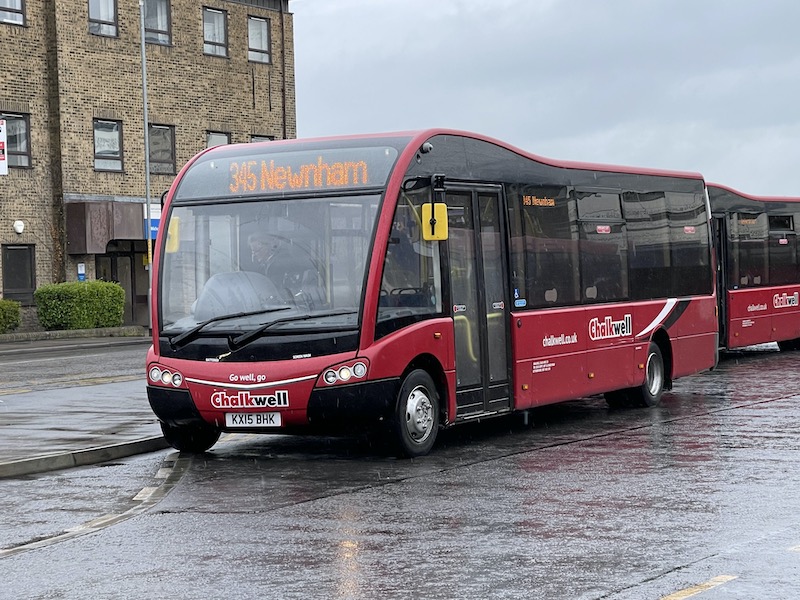
I took a ride out to Newnham on route 345 at 11:00 and to Bredgar on route 343 at 12:10. The former took a couple of women and their shopping trolleys home close to Sittingbourne School just about five minutes into the journey and a family of four all the way to Newnham, which is a pleasant half an hour’s rural ride south of Sittingbourne.
We brought three passengers back into SIttingbourne on the 11:35 return from Newnham.

The 12:10 route 343 took a couple of passengers a few stops south in Sittingbourne with one other passenger on board for 11 minutes to Rodmersham Green and then no-one for the next 15 minutes to the village of Bredgar.
No-one travelled on the return journey at 12:37 from Bredgar.

It’s not looking good for the 343, 344 and 345.

In my three excursions I travelled on bus routes costing the taxpayer well over half a million pounds to fund and it’s heartbreaking to see such poor use being made of them. There’ll be howls of protest if they’re withdrawn. There’ll be negative headlines. And there will be a small number of people left completely isolated. But half a million pounds is a high price to enable these routes catering for so few people to continue.
Meanwhile more rural DRT schemes are coming on stream this month thanks to the DfT’s £20 million Rural Mobility Fund. I doubt residents of Bean, Edenbridge, Conyer, Newnham, Doddington, Lynsted and Bredgar will be overjoyed to know that.
And I can imagine they’ll be even more astonished if they lose their bus routes just as Kent receives £35.1 million to improve bus services to emulate London’s “success”.
Interesting times ahead.

Roger French
Blogging timetable: 06:00 TThS.

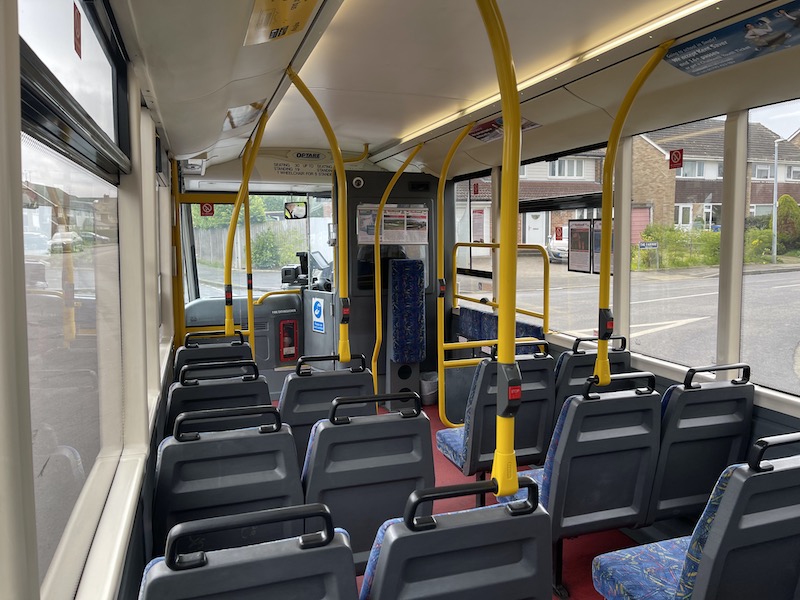
Worcestershire are one area that failed to win any funding whilst First Midland Red Buses Limited have announced the historic 144 from Brum to The Malverns (44) will end on 24th April 2022 .
LikeLike
£141K for the Edenbridge E1 town service strikes me as VERY expensive for a ‘tween schools service. Maybe ther is a school contract (private) worked in with that price?? {Or should it’ve been £41K?? That sounds better!!}.
I see no future for Bean . . . but is Bluewater the correct destination for the route? Dartford was the historic destination, and passengers won’t change buses (with the attendant risks) . . . they’ll use the car.
In Edenbridge . . . I doubt that any form of intervention would save the E1.
However, the points about the Sittingbourne hamlets and their residents being abandoned is well made . . . but is there really no alternative? Even one bus providing a “to-town; 2 hours shopping; from-town” service ought to be possible using a 16-seater minibus at a reasonable price. Even if only 2-3 days per week . . . it’s better than nowt.
Have we done ourselves a dis-service by demanding that all buses MUST be fully-accessible?? I bet Mrs Scroggins would prefer to have a couple of small steps to climb into a Sprinter rather than lose her bus altogether!!
LikeLike
If the buses to be cut are also providing school bus services, while that mean that the current providers will hand back these school contracts as being non-viable? If they are re-let, they may have to be at a higher price, therefore any savings being made by cutting normal bus services may be swallowed up by having to increase the funding of the school services.
LikeLike
This just ensures the spiral of decline with bus services continues. As can be seen from this blog nearly all the passengers the bus companies get are Concessionary pass holders with very few fare paying passengers and they are no even that successful in attracting concessionary pass holders
Bus service are already in much of England at a skeleton service level and operating at very low frequencies and often at irregular frequencies and days. That’s simply not doing to attract passengers or even retain existing passengers
Cuts to services as well drive up the fixed costs. Putting up fares is simply not sensible when they are already far to high and in any case they have very few fare paying passengers. Passengers just do not see bus service as providing value for money and cuts to service and increased fares will just drive more fare paying passengers away
BSIP appears to have turned into a disaster for bus service with about 55% of LTA’S having got nothing and the rest mainly having got less then they asked for
By the time the LTA’s have spent a lot of the money on themselves there will not be a lot left to spend on improving service in fact I think most of the money will be spent on just stabilizing the services ie stopping more routes being axed
For those area that have not got funding it is a complete disaster as they face in the region of 20% bus cuts unless passenger numbers recover by October or more funding is found. Both those seem unlikely
To get passengers back on bus major improvements need to be made to service in order to attract passengers
To do that investment is needed and that will not come cheap
Options are
a) Some Government funding
b) Annual chare for concessionary passes
c) Car Parking tax
d) Requirement for councils to spend a percentage of council tax on bus services
LikeLike
At a time the elderly and disabled are facing extreme utility and food cost inflation the idea of charging for Concessionary Bus Travel beggers belief that anyone would wish to make the most vulnerable in society pay even more is staggering.
LikeLike
It i either that or no buses
LikeLike
Birmingham has had free bus passes since 1958 & we actually use our bus network. Why on earth should others pay for buses nobody uses when demand responsive services could be bettered targeted. In Birmingham Concessionary users also get free travel on trains and metro if we can do it other authorities can but frankly buses should only run if someone is actually using them what you propose is a poll tax on the vulnerable & remember Diamond Bus & NXWM offer a commercial pre 9.30 ticket for just a £1 !
LikeLike
Rod Stewart and Dartford alumni mick jagger are concessionary pass holders.. just because someone is of pensionable age does not automatically make them “most vulnerable”
LikeLike
Unless Rod Stewart or Mick Jagger actually use the bus which frankly is unlikely it costs us nothing after issuing the pass for them to hold a pass as renumeration only occurs when touched in. The argument about Rod & Mick holding passes is simply a laughable red herring
LikeLike
The town service 9 to Kenilworth Court and Eden Village uses one bus in the off-peak. An area that previous operators have struggled to serve, and seven or so years ago residents objected strongly to the planned bus link that was intended to link the end of the new Eden Village into the circuit which would have allowed a much better timetable.
An extra bus was needed for a couple of hours to cater for the post 0930 passes. The three rural ‘arms’ were otherwise scheduled to be operated by one bus on an almost two-hourly frequency.
The Newnham and Conyer ‘arms’ each needed a full-size bus at school times as they also catered for entitled scholars from Teynham. Similar problem with the 326/7 with two full-sized vehicles needed for scholar flow to Sittingbourne, and one for the flow to Rainham/Chatham! The Bredgar ‘arm’ used a midi-bus in the peak that could then do the rural ‘arms’ in the off-peak.
In those days pass holders were younger – raising the age of availability simply persuades many to use the car.
On the rural map, you may also notice the small hamlets of Milstead, Wormshill and Frinsted a deeply rural area served from c 1973 by a post bus. Before that Jessops of Frinsted since 1930 (or slightly earlier) used an elderly Bedford OB on an Express licence into Sittingbourne on Fridays.
(Bit of an advert if anyone is interested in ‘Sittingbourne’s forgotten bus operators, which yours truly wrote and had published through the Omnibus Society a couple of years ago.)
LikeLike
Another interesting, if somewhat depressing, post Roger! I do think it is rather unfair to call it a BSIP lottery – there’s no evidence that the DfT didn’t apply the same criteria when considering each bid and some Local Authorities were told well in advance that their ambitions fell short of what was expected so they can’t really be surprised if ultimately they didn’t get any funding. Given my past experience of Worcestershire (no real website presence, no cohesive approach to roadside infrastructure etc etc), I find it completely unsurprising they came away with nothing! Some LAs haven’t subsidised a local bus in years so for them to develop an improvement plan as well as set up an Enhanced Partnership was always a big ask and there must have been some fairly gaping credibility gaps….
There is an argument to say it’s better fewer LAs get funding then everyone getting something and the funding being spread too thinly.
Hertfordshire is something of an island of funding with the adjacent counties of Bucks, Cambs and Essex all missing out. This rather makes joint funding of cross-boundary services more problematic. Credit is due to Central Beds though!
Any County with BSIP funding has at least more tools to maybe serve at-risk settlements in a different way. The DfT is adamant that funding shouldn’t be used to prop-up existing networks, but there’s absolutely no reason why some of these villages shouldn’t benefit by being integrated into a revised pattern of services which may take people where they actually want to go. These days it may not necessarily be the nearest town centre as Roger’s trips suggest…
LikeLike
Just what I feared. Hampshire will be in dire trouble. No money for Tory -voting areas.
Yes, of course we would rather have a bus to pay for than have no buses at all, which seems likely in many rural areas.! In France non-urban buses, of which there are very few, are normally run by women part-timers, who also drive the school buses. I have never understood why the Dept of Tpt never looks across the Channel.
LikeLike
Quite a number of SNCF rural train services are actually run with buses.
Of course France’s population density is a lot lower than England’s.
LikeLike
It could be that if a but route is not commercially viable it could be looked at s running it as a community bus and a small charge is made for for concessionary passes, Given about 80% of passengers are pass holders it could make the difference bettween having a bus and no bus
LikeLike
Better no bus then why should services be supported when there is no demand for them forcing vulnerable people who use services that are used to pay for others. A ridiculous idea that only exists with armchair bus enthusiasts.
LikeLike
Thanks Roger for an update on services I used to be intimately involved with. My first comment is to say how well presented all three operators’ vehicles are and also, apparently, adherence to the timetables.
The Sittingbourne rural services 344/345 have been under contract to Kent County Council since dereg. in ’86 and in fact were part of a group of contracts introduced a few months early, ahead of “D” day, to enable the County Council and operators to gain some experience of the tendering procedure before tackling the main bloc. This was done with the full co-operation of Maidstone & District, the incumbent operator, who lost the work to Smith’s Coaches (no longer in business). As far as I recall this group of services has never returned to Maidstone & District/Arriva in the many subsequent rounds of re-tendering.
These have always offered a full spread of day-time facilities for the villages concerned catering for the 9-to-5, schools and shoppers’ requirements with careful attention needed to the very heavy school flows on the Teynham corridor in conjunction with commercially operated services. But despite having these consistently funded and stable services over so many years they seem to be largely neglected by the local communities and are perhaps irrelevant to the majority of the population. Better marketing could no doubt increase passenger numbers but I suspect only marginally – could the Parish Councils be given some sort of stake, taking the services under their wing(s) to nurture them and promote ridership on what must be considered valuable local assets?
I’m not aware of the current arrangements for scholars but in the past entitled children would have generated a significant proportion of revenue – will the Education Department now be forced into funding replacement school contracts?
And there’s a lot of new housing around Sittingbourne – some on parts of these routes.
My final thought echoes Roger’s – the ironic situation with new money for innovation whilst existing facilities disappear.
LikeLike
Parish coumcils have very little funding
LikeLike
What is interesting is Brum with its cohesive long term plan for Transport has been awarded nearly £90m for buses which people actually use whilst adjoining Worcestershire where no one uses buses an absolute zero after its ludicrously stupid bid . Why support buses in Worcestershire when no uses them even First Midland Red is axing the 144 because no one uses it funding should go to areas that use buses & not middle class vanity projects that achieve nothing.
LikeLike
Parish Councils are funded by a precept added to Council Tax bills. As far as I’m aware they can set this at whatever level they feel is appropriate.
LikeLike
Full list of all bus routes being cut in NewcaFull list of all bus routes being cut in Newcastle and North Tyneside amid transport crisis
https://www.chroniclelive.co.uk/news/north-east-news/full-list-bus-routes-being-23190646
LikeLike
Strange we have no cuts in Birmingham save for normal timetable amendments on 24th April and the lowest fares in England.
LikeLike
It is easier to run buses in the large cities . THe buses run at least 6 days a week and start early and finish late
In the smller towns the buses do not start untill at least 7am and finish by about 6 and are very infrequent hence all rthey carry are concessionary pass holders and school children, Thus the majority of the population is not catered for so they dont use them
LikeLike
If there was a demand in these areas then the market will meet it. I live outside the City and the market meets the demands for buses it applies here and everywhere else why run buses no one wants to use its simply a matter of economics
LikeLike
How can the market meet it. There are no buses to use
LikeLike
Presumably it is a question of supply and demand one would assume operators previously supplied buses but as consequently there was no demand there is now no buses its how the market works funny enough Supply & Demand. If there is a need to socially necessary bus services it is up to the local authority to provide it simple.
LikeLike
No in the real world outside of public tranport the market works by providing services that people need and not providing services that are of no use to them
Currently the bus market ignore 80% of potential cusomers and does not run at times or go to places people need to go
LikeLike
The bus “industry” under the current regulatory framework in England in the same as any other industry it is a commercial operation which meets the cyclical demand for its product and runs to the places its customer base wants to go to at the times the customer uses it. Anything outside of this is the responsibility of the local authority. In the real world it is up to the local authority to provide services which are not commercial to the market.
LikeLike
The VERY expensive Edenbridge town service was a very odd innovation, and only abstracts revenue from Metrobus and Southdown PSV passengers in the Fircroft Way estate section. The rest of the route through Troy Town was carrying fresh air sixty years ago when operated by London Transport’s 434/473. Ironically, the E1 was introduced just as the entire surrounding rural service network (232/4/7/8 and the former 404) became DRT, which translated, mean expensive taxis which preclude casual travellers, few use, and which will also be withdrawn eventually on cost grounds.
The Sittingbourne situation, absolutely and very sadly, underlines just how far car dependence in many Southern towns has now become. It was the area chosen by Maidstone and District to introduce a more frequent mini-bus network just prior to deregulation, and buses were bursting at the seams. Now, and in spite of huge amounts of new homes in the area, even the town services are carrying penny numbers. Costs clearly need to be reduced, and although I normally come from the “use it or lose it” school of thought, total abandonment should not be considered. As in many similar places, a restructuring of services, perhaps to certain days of the week rather than as now, re-routing, such as once more extending the Newnham service to Faversham could all be considered. And yes, there are huge numbers of school vehicles and their Drivers available for such work in-between schools, and the requirement that absolutely everything MUST be fully accessible has caused unnecessary withdrawal of services..
Quite what Kent are going to use their £millions on if prevented from “propping up” existing services remains to be seen, and I fear much will be wasted on grandiose, “eye-catching” schemes which will fade away in time, and be of no benefit at all to the average current bus passenger.
And Sprinters are low-floor.
LikeLike
In fact a restructuring of services, perhaps to certain days of the week, was what Warwickshire County Council did in 2011, when funding for bus services was last drastically reduced. Funded Mon-Fri services were replaced by an expansion of of the county’s Flexibus network using minibuses (see https://www.warwickshire.gov.uk/flexibus for a brief outline) with most services running just one or two days a week between school contracts.
Almost every settlement has kept at least a weekly service – and eleven years later the network still survives.
LikeLike
Isn’t the Flexbus network now operated by West Midlands Travel Limited in partnership with Warwickshire County Council.
LikeLike
National Express Accessible Transport (NEAT) is now one of three operators providing Flexibus services under Warwickshire County Council contracts. The services are tendered every few years in the same way as other funded bus services.
LikeLike
Just a few thoughts as I don’t know Sittingbourne. Is the town centre any good? Are the two centre car parks busy and how much does it cost to park?
Perhaps if the bus network focused on timed connections with the trains (with the town centre as a calling poin) and advertised as such, people would have other reasons to use the buses as they would provide access to many more places. This is the norm in Switzerland.
LikeLike
Just a few thoughts as I don’t know Sittingbourne. Is the town centre any good? Are the town centre car parks busy and how much does it cost to park?
Perhaps if the bus network focused on timed connections with the trains (with the town centre as a calling point) and advertised as such, people would have other reasons to use the buses as they would provide access to many more places. This is the norm in Switzerland.
LikeLike
To answer Peter, Sittingbourne town centre is somewhat weak, though the only “out-of-town” retail park is in fact barely a 5 minute walk from the town centre bus hub, that is virtually opposite the station. As for train connections, there were – pre-Covid – five London-bound, five coastbound and two Sheerness trains an hour. That’s shrunk to three and one respectively at the moment, but still doesn’t provide a clear indication as to which you would specifically try to connect with.
LikeLike
Another Route Axed
34 St Albans to Dunstable
LikeLike
But to be replaced on a partly-commercial basis by another operator to a similar frequency.
LikeLike
Curious comment from Malcolm Chase “No money for Tory -voting areas”. A quick analysis shows that of the 12 of the successful 31 authorities are Conservative controlled and a further 8 have No Overall Control. The 12 successful Conservative controlled authorities received £281,100,000 (if you split the joint Lancs / Blackburn BSIP into two and include this). This does not quite equate with “No money” in my books. The failure of the Hampshire bid may be more to do with the quality of their BSIP bid than the colour of the LA controlling party..
LikeLiked by 1 person
This article questions the government’s BSIP allocation rationale, arguing that historically underfunded LTAs would struggle to produce ambitious plans.
https://www.busandcoachbuyer.com/39682-2/
My thoughts are that if we still have a NATIONAL bus strategy then the government needs to say how it is going forward with the LTAs who’s BSIPs are unfunded, given the so called Levelling Up agenda.
LikeLike
Hello Roger Just picking up on your comment about the Campaign for Better Transport research. This was based on DfT data on vehicle Kms rather than registrations. (Although changes in ‘live’ or net registrations was the same in the same period). Hope this helps Norman
LikeLike
Thanks Norman.
LikeLike
BSIP Funding
The BSIP funding started as £7B then informally it was suggested it was halved and now we find only £1B appears to have been allocated but with goverenment funding it is always very murky. Possibly there is some funding to be announced for electric buses. Where the rest has gone who knows
LikeLike
Shame about the Edenbridge E1, but – presumably as a fill-in-between-school-trips – it doesn’t offer much more than a morning shopping service to part of the town (Edenbr.total pop. 8,000), plus hospital visits. It does connect reasonably with the 236 to/from Westerham, to give 3 hours there, and similarly with the trains to/from Oxted (3 hours) and Croydon (2 hours+). Did you notice any leaflets publicising these travel opportunities?
Trips to Tonbridge and Redhill involve long connections either outward or returning, so you’d only get 2 hours in those towns). Tunbridge Wells and Sevenoaks would not be worth the attempt. Otherwise, the E1 doesn’t enable work travel to/from Edenbridge itself, or commuting to London or any other big Kent/Surrey/Sussex towns. Or, for that matter, an afternoon or evening out anywhere!
It does seem to me that a Swiss Taktfahrplan approach, though buses might run less frequently, should offer a vastly greater range of travel – to more places and over more of the day.
LikeLike